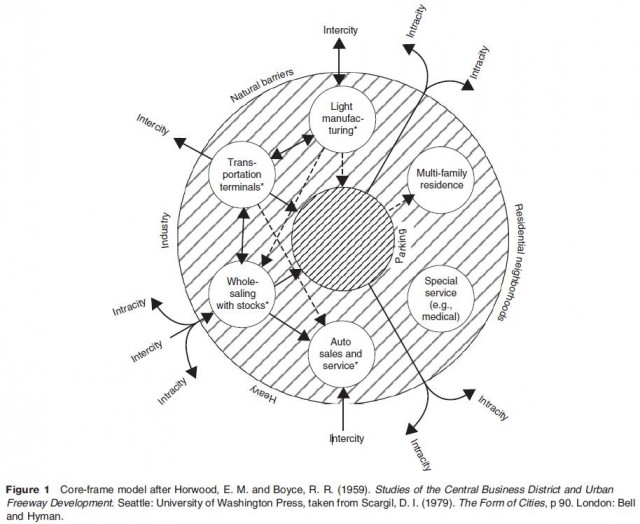Defining the Central Business District

This core frame spatial organization is also evident in non Western cities like Cape Town where the CBD is flanked by industrial parks in the southern suburbs of Claremont, Rondebosch, and Wynberg. Similarly, in UK cities other activities requiring less relative centrality, including court houses and libraries, are located toward the edge of the core while functional nodes make up the surrounding frame. Glasgow's CBD is a case in point with the Mitchell Library, Sheriff Court and warehouse cluster located outside the main core area that is demarcated by primary retail streets. These frame functions tend to be focused around smaller nuclei but in cases like the Tees Valley outside Newcastle in Northeast England the nuclei can grow into an extensive industrial complex. In Southern California the growth of light industrial technopoles in Palmdale are located some 60 miles to the north of the CBD in Los Angeles. In other cases, this decentralization proper is flanked by widespread residential sprawl and the rise of suburbia that in turn is stabilized by 'megamalls', including the Mall of America and the West Edmonton Mall. Consequently, core frame definitions of the CBD are now well overstretched.
Despite definitional nuances and morphological variations, it is generally accepted that the CBD is characterized by a concentration of high order service activities that include retailing, office, legal, and other municipal functions. The literature suggests that there are three main reasons for the clustering of these activities with 'unique accessibility' being the first and most important. This is an 'all roads lead to Rome' type scenario and places the CBD at the hub of the primary transport network. Chicago's famous Loop is designed in this way with office complexes built above railway stations to fully exploit the local labor force. Second, the clustering of commercial activity can also bring economic advantages. While land use varies in the CBD, most of the functions are complimentary and independent. Firms can achieve external economies of scale by having access to what is, in effect, a proximate pool of common services. Numerous studies of London show the extent of spatial linkages between different types of office activities that include press, industry, insurance, banking, and commodities. Third, there are also behavioral reasons that help explain the centrality of high order service activities. In the business world a city center address arguably carries more prestige and the ability to afford such an expensive location is perceived as a sign of success. The 'skyscraper infatuation' that swept through 1920s America was characterized by the erection of prestigious tower buildings established as landmarks to illustrious entrepreneurs. Furthermore, the social scene and leisure economy concentrated in and around the CBD further facilitates personal communication and tacit forms of knowledge favored by many businesses.